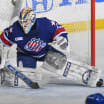Ryan Miller walked onto the KeyBank Center floor in June and looked up at the video board, where a message from Rick Jeanneret awaited him.
"Ryan, for five-plus decades, no player has worn the Buffalo Sabres sweater with more authenticity, intensity, and pride than you did for 12 unforgettable years," Jeanneret said.
Jeanneret went on to announce what will finally come to fruition tonight. Miller will be inducted into the Buffalo Sabres Hall of Fame and have his number retired to the KeyBank Center rafters, alongside Jeanneret and the goaltender who preceded him in Buffalo, Dominik Hasek.
The words of the Sabres' Hall-of-Fame broadcaster are echoed by those who played alongside Miller as well as those who watched him throughout his decorated career with the Sabres, during which he became the franchise's all-time leader in wins by a goaltender and earned the Vezina Trophy in 2009-10.
'That's his town' | Coaches, teammates discuss Miller's time in Buffalo
Sabres all-time wins leader will have his No. 30 retired on Thursday

© Bill Wippert/Getty Images
Highlights: Ryan Miller's tenure with the Sabres
Ryan Miller's message to Owen Power
Miller reviews his old Sabres jerseys


















